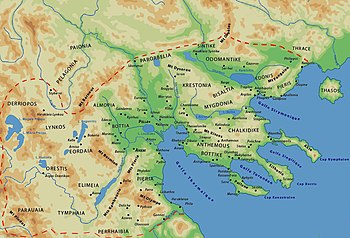Pelagonia


Pelagonia (Macedonian: Пелагонија, romanized: Pelagonija; Greek: Πελαγονία, romanized: Pelagonía) is a geographical region of Macedonia named after the ancient kingdom. Ancient Pelagonia roughly corresponded to the present-day municipalities of Bitola, Prilep, Mogila, Novaci, Kruševo, and Krivogaštani in North Macedonia and to the municipalities of Florina, Amyntaio and Prespes in Greece.
History

In antiquity, Pelagonia was roughly bounded by
Molossian tribal state or koinon.[1][2][3] The region was annexed to the Macedonian kingdom during the 4th century BC and became one of its administrative provinces. In medieval times, when the names of Lynkestis and Orestis had become obsolete, Pelagonia acquired a broader meaning. This is why the Battle of Pelagonia (1259) between Byzantines and Latins includes also the current Kastoria regional unit
and ancient Orestis.
Strabo calls Pelagonia by the name Tripolitis
Today, Pelagonia is a plain shared between
double axe, later found in Mycenae[citation needed] and are exhibited in the Museum of Bitola.[citation needed
]
Environment
Important Bird Area
A 137,000 ha tract of the plain has been designated an
Eurasian thick-knees, little owls, Eurasian scops owls, European rollers, lesser kestrels and lesser grey shrikes.[6]
See also
- List of Ancient Greek tribes
- Pelagonia statistical region
References
- ^ Strabo 9.5: For in consequence of the renown and ascendency of the Thessalians and Macedonians, those Epeirote, who bordered nearest upon them, became, some voluntarily, others by force, incorporated among the Macedonians and Thessalians. In this manner the Athamanes, Aethices, and Talares were joined to the Thessalians, and the Orestae, Pelagones, and Elimiotae to the Macedonians.
- ^ John Boardman and N. G. L. Hammond. The Cambridge Ancient History Volume 3, Part 3: The Expansion of the Greek World, Eighth to Sixth Centuries BC. Cambridge: Cambridge University Press, 1982, p. 284.
- ^ A J Toynbee. Some Problems of Greek History, Pp 80; 99-103
- ^ Strabo. Geographica, 7.327.
- ^ Bosworth, A.B. "Philip II and Upper Macedonia", CQ, 21 (1971).
- ^ "Pelagonia". BirdLife Data Zone. BirdLife International. 2021. Retrieved 12 March 2021.
